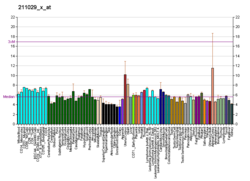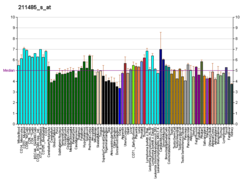Fibroblast growth factor 18 (FGF-18) is a protein that is encoded by the FGF18 gene in humans.[5][6][7] The protein was first discovered in 1998, when two newly-identified murine genes Fgf17 and Fgf18 were described and confirmed as being closely related by sequence homology to Fgf8.[8] The three proteins were eventually grouped into the FGF8 subfamily, which contains several of the endocrine FGF superfamily members FGF8, FGF17, and FGF18.[9] Subsequent studies identified FGF18's role in promoting chondrogenesis,[10] and an apparent specific activity for the generation of the hyaline cartilage in articular joints.[11]
The protein encoded by this gene is a member of the fibroblast growth factor (FGF) family. FGF family members possess broad mitogenic and cell survival activities, and are involved in a variety of biological processes, including embryonic development, cell growth, morphogenesis, and tissue repair. It has been shown in vitro that this protein is able to induce neurite outgrowth in PC12 cells.[12]
Function
editFGF18 signals through fibroblast growth factor receptor (FGFR) family, preferentially binding FGFR 3c (followed by 4△, 2c, 1c, and finally 3b),[13] signaling via FGFR3 promotes generation of cartilage (chondrogenesis).[14] FGF18 and has been shown to cause thickening of cartilage in a murine model of osteoarthritis,[15] and the recombinant version of it (sprifermin) is in a clinical trial as a potential treatment for osteoarthritis (OA).[16] Recent findings from a placebo-controlled randomized clinical study demonstrate the potential of FGF18 to reduce the rate of progression to joint replacement surgery[17] and delay progression of OA-related pain (WOMAC).[18] Another study suggested the ability of FGF18 to inhibit intravertebral disc degeneration in a rabbit model of the disease.
Studies of the similar proteins in mouse and chick suggested that this protein is a pleiotropic growth factor that stimulates proliferation in a number of tissues, most notably the liver and small intestine. Knockout studies of the similar gene in mice implied the role of this protein in regulating proliferation and differentiation of midline cerebellar structures.[7]
FGF18 appears to be a pleiotropic factor, expressed in a broad range of tissues and organs; the highest level of FGF18 expression were confirmed in the right ventricle interventricular septum of the heart.[19] The role of FGF18 in the heart appears to be associated with protection from stress-induced pathological cardiac hypertrophy via the induction of survival or regenerative signals.[20] Similarly, studies confirmed that overexpression of FGF18 in the liver was able to attenuate liver fibrosis following chemically-induced injury.[21]
Studies of FGF18 in relation to oncology have shown both decreased levels[22] and increased levels[23] of FGF18 in a number of cancer types and stages, however, FGF18 does not appear to be causative or prognostic[24] and long-term clinical studies of the FGF18 analog, sprifermin, have demonstrated an excellent safety profile with no reported oncogenic effects.[25]
References
edit- ^ a b c GRCh38: Ensembl release 89: ENSG00000156427 – Ensembl, May 2017
- ^ a b c GRCm38: Ensembl release 89: ENSMUSG00000057967 – Ensembl, May 2017
- ^ "Human PubMed Reference:". National Center for Biotechnology Information, U.S. National Library of Medicine.
- ^ "Mouse PubMed Reference:". National Center for Biotechnology Information, U.S. National Library of Medicine.
- ^ Ohbayashi N, Hoshikawa M, Kimura S, Yamasaki M, Fukui S, Itoh N (Aug 1998). "Structure and expression of the mRNA encoding a novel fibroblast growth factor, FGF-18". J Biol Chem. 273 (29): 18161–4. doi:10.1074/jbc.273.29.18161. PMID 9660775.
- ^ Hu MC, Qiu WR, Wang YP, Hill D, Ring BD, Scully S, Bolon B, DeRose M, Luethy R, Simonet WS, Arakawa T, Danilenko DM (Nov 1998). "FGF-18, a Novel Member of the Fibroblast Growth Factor Family, Stimulates Hepatic and Intestinal Proliferation". Mol Cell Biol. 18 (10): 6063–74. doi:10.1128/MCB.18.10.6063. PMC 109192. PMID 9742123.
- ^ a b "Entrez Gene: FGF18 fibroblast growth factor 18".
- ^ Maruoka Y, Ohbayashi N, Hoshikawa M, Itoh N, Hogan BL, Furuta Y (June 1998). "Comparison of the expression of three highly related genes, Fgf8, Fgf17 and Fgf18, in the mouse embryo". Mechanisms of Development. 74 (1–2): 175–177. doi:10.1016/s0925-4773(98)00061-6. ISSN 0925-4773. PMID 9651520. S2CID 18400935.
- ^ Itoh N, Ornitz DM (November 2004). "Evolution of the Fgf and Fgfr gene families". Trends in Genetics. 20 (11): 563–569. doi:10.1016/j.tig.2004.08.007. ISSN 0168-9525. PMID 15475116.
- ^ Moore EE, Bendele AM, Thompson DL, Littau A, Waggie KS, Reardon B, Ellsworth JL (July 2005). "Fibroblast growth factor-18 stimulates chondrogenesis and cartilage repair in a rat model of injury-induced osteoarthritis". Osteoarthritis and Cartilage. 13 (7): 623–631. doi:10.1016/j.joca.2005.03.003. ISSN 1063-4584. PMID 15896984.
- ^ Hollander JM, Goraltchouk A, Rawal M, Liu J, Luppino F, Zeng L, Seregin A (2023-03-06). "Adeno-Associated Virus-Delivered Fibroblast Growth Factor 18 Gene Therapy Promotes Cartilage Anabolism". Cartilage. 14 (4): 492–505. doi:10.1177/19476035231158774. ISSN 1947-6043. PMC 10807742. PMID 36879540. S2CID 257376179.
- ^ Ohbayashi N, Hoshikawa M, Kimura S, Yamasaki M, Fukui S, Itoh N (1998-07-17). "Structure and expression of the mRNA encoding a novel fibroblast growth factor, FGF-18". The Journal of Biological Chemistry. 273 (29): 18161–18164. doi:10.1074/jbc.273.29.18161. ISSN 0021-9258. PMID 9660775.
- ^ Ornitz DM, Itoh N (2015). "The Fibroblast Growth Factor signaling pathway". Wiley Interdisciplinary Reviews. Developmental Biology. 4 (3): 215–266. doi:10.1002/wdev.176. ISSN 1759-7692. PMC 4393358. PMID 25772309.
- ^ Davidson D, Blanc A, Filion D, Wang H, Plut P, Pfeffer G, Buschmann MD, Henderson JE (2005). "Fibroblast Growth Factor (FGF) 18 Signals through FGF Receptor 3 to Promote Chondrogenesis". Journal of Biological Chemistry. 280 (21): 20509–20515. doi:10.1074/jbc.M410148200. PMID 15781473.
- ^ Moore E, Bendele A, Thompson D, Littau A, Waggie K, Reardon B, Ellsworth J (2005). "Fibroblast growth factor-18 stimulates chondrogenesis and cartilage repair in a rat model of injury-induced osteoarthritis". Osteoarthritis and Cartilage. 13 (7): 623–631. doi:10.1016/j.joca.2005.03.003. PMID 15896984.
- ^ Merck Announces Collaboration With Nordic Bioscience for Sprifermin in Osteoarthritis of the Knee, retrieved 2013-04-02
- ^ Eckstein F, Hochberg MC, Guehring H, Moreau F, Ona V, Bihlet AR, Byrjalsen I, Andersen JR, Daelken B, Guenther O, Ladel C, Michaelis M, Conaghan PG (August 2021). "Long-term structural and symptomatic effects of intra-articular sprifermin in patients with knee osteoarthritis: 5-year results from the FORWARD study". Annals of the Rheumatic Diseases. 80 (8): 1062–1069. doi:10.1136/annrheumdis-2020-219181. ISSN 1468-2060. PMC 8292562. PMID 33962962.
- ^ Conaghan PG, Katz N, Hunter D, Guermazi A, Hochberg M, Somberg K, Clive J, Johnson M, Goel N (2023-06-01). "Pos1348 Effects of Sprifermin on a Novel Outcome of Osteoarthritis Symptom Progression: Post-Hoc Analysis of the Forward Randomized Trial". Annals of the Rheumatic Diseases. 82 (Suppl 1): 1025–1026. doi:10.1136/annrheumdis-2023-eular.2454. ISSN 0003-4967.
- ^ "Genevisible: O76093". Genevisible. Retrieved Jul 22, 2023.
- ^ "fgf18 heart - Search Results - PubMed". PubMed. Retrieved 2023-07-22.
- ^ Tong G, Chen X, Lee J, Fan J, Li S, Zhu K, Hu Z, Mei L, Sui Y, Dong Y, Chen R, Jin Z, Zhou B, Li X, Wang X (April 2022). "Fibroblast growth factor 18 attenuates liver fibrosis and HSCs activation via the SMO-LATS1-YAP pathway". Pharmacological Research. 178: 106139. doi:10.1016/j.phrs.2022.106139. ISSN 1096-1186. PMID 35202822. S2CID 247030847.
- ^ Mosleh B, Schelch K, Mohr T, Klikovits T, Wagner C, Ratzinger L, Dong Y, Sinn K, Ries A, Berger W, Grasl-Kraupp B, Hoetzenecker K, Laszlo V, Dome B, Hegedus B (2023-06-21). "Circulating FGF18 is decreased in pleural mesothelioma but not correlated with disease prognosis". Thoracic Cancer. 14 (22): 2177–2186. doi:10.1111/1759-7714.15004. ISSN 1759-7714. PMC 10396789. PMID 37340889. S2CID 259210554.
- ^ Flannery CA, Fleming AG, Choe GH, Naqvi H, Zhang M, Sharma A, Taylor HS (October 2016). "Endometrial Cancer-Associated FGF18 Expression Is Reduced by Bazedoxifene in Human Endometrial Stromal Cells In Vitro and in Murine Endometrium". Endocrinology. 157 (10): 3699–3708. doi:10.1210/en.2016-1233. ISSN 1945-7170. PMC 5045514. PMID 27267714.
- ^ "Expression of FGF18 in cancer - Summary - The Human Protein Atlas". www.proteinatlas.org. Retrieved 2023-07-22.
- ^ Eckstein F, Hochberg MC, Guehring H, Moreau F, Ona V, Bihlet AR, Byrjalsen I, Andersen JR, Daelken B, Guenther O, Ladel C, Michaelis M, Conaghan PG (August 2021). "Long-term structural and symptomatic effects of intra-articular sprifermin in patients with knee osteoarthritis: 5-year results from the FORWARD study". Annals of the Rheumatic Diseases. 80 (8): 1062–1069. doi:10.1136/annrheumdis-2020-219181. ISSN 1468-2060. PMC 8292562. PMID 33962962.
Further reading
edit- Haque T, Nakada S, Hamdy RC (2007). "A review of FGF18: Its expression, signaling pathways and possible functions during embryogenesis and post-natal development". Histol. Histopathol. 22 (1): 97–105. PMID 17128416.
- Hu MC, Wang YP, Qiu WR (1999). "Human fibroblast growth factor-18 stimulates fibroblast cell proliferation and is mapped to chromosome 14p11". Oncogene. 18 (16): 2635–42. doi:10.1038/sj.onc.1202616. PMID 10353607. S2CID 32973576.
- Xu J, Liu Z, Ornitz DM (2000). "Temporal and spatial gradients of Fgf8 and Fgf17 regulate proliferation and differentiation of midline cerebellar structures". Development. 127 (9): 1833–43. doi:10.1242/dev.127.9.1833. PMID 10751172.
- Hartley JL, Temple GF, Brasch MA (2001). "DNA Cloning Using In Vitro Site-Specific Recombination". Genome Res. 10 (11): 1788–95. doi:10.1101/gr.143000. PMC 310948. PMID 11076863.
- Whitmore TE, Maurer MF, Sexson S, Raymond F, Conklin D, Deisher T (2001). "Assignment of fibroblast growth factor 18 (FGF18) to human chromosome 5q34 by use of radiation hybrid mapping and fluorescence in situ hybridization". Cytogenet. Cell Genet. 90 (3–4): 231–3. doi:10.1159/000056775. PMID 11124520. S2CID 84820296.
- Simpson JC, Wellenreuther R, Poustka A, Pepperkok R, Wiemann S (2001). "Systematic subcellular localization of novel proteins identified by large-scale cDNA sequencing". EMBO Rep. 1 (3): 287–92. doi:10.1093/embo-reports/kvd058. PMC 1083732. PMID 11256614.
- Strausberg RL, Feingold EA, Grouse LH, Derge JG, Klausner RD, Collins FS, Wagner L, Shenmen CM, Schuler GD (2003). "Generation and initial analysis of more than 15,000 full-length human and mouse cDNA sequences". Proc. Natl. Acad. Sci. U.S.A. 99 (26): 16899–903. Bibcode:2002PNAS...9916899M. doi:10.1073/pnas.242603899. PMC 139241. PMID 12477932.
- Clark HF, Gurney AL, Abaya E, Baker K, Baldwin D, Brush J, Chen J, Chow B, Chui C (2003). "The Secreted Protein Discovery Initiative (SPDI), a Large-Scale Effort to Identify Novel Human Secreted and Transmembrane Proteins: A Bioinformatics Assessment". Genome Res. 13 (10): 2265–70. doi:10.1101/gr.1293003. PMC 403697. PMID 12975309.
- Popovici C, Conchonaud F, Birnbaum D, Roubin R (2004). "Functional phylogeny relates LET-756 to fibroblast growth factor 9". J. Biol. Chem. 279 (38): 40146–52. doi:10.1074/jbc.M405795200. PMID 15199049.
- Gerhard DS, Wagner L, Feingold EA, Shenmen CM, Grouse LH, Schuler G, Klein SL, Old S, Rasooly R (2004). "The Status, Quality, and Expansion of the NIH Full-Length cDNA Project: The Mammalian Gene Collection (MGC)". Genome Res. 14 (10B): 2121–7. doi:10.1101/gr.2596504. PMC 528928. PMID 15489334.
- Wiemann S, Arlt D, Huber W, Wellenreuther R, Schleeger S, Mehrle A, Bechtel S, Sauermann M, Korf U (2004). "From ORFeome to Biology: A Functional Genomics Pipeline". Genome Res. 14 (10B): 2136–44. doi:10.1101/gr.2576704. PMC 528930. PMID 15489336.
- Cormier S, Leroy C, Delezoide AL, Silve C (2005). "Expression of fibroblast growth factors 18 and 23 during human embryonic and fetal development". Gene Expr. Patterns. 5 (4): 569–73. doi:10.1016/j.modgep.2004.10.008. PMID 15749088.
- Antoine M, Wirz W, Tag CG, Mavituna M, Emans N, Korff T, Stoldt V, Gressner AM, Kiefer P (2005). "Expression pattern of fibroblast growth factors (FGFs), their receptors and antagonists in primary endothelial cells and vascular smooth muscle cells". Growth Factors. 23 (2): 87–95. doi:10.1080/08977190500096004. PMID 16019430. S2CID 27380246.
- Mehrle A, Rosenfelder H, Schupp I, Del Val C, Arlt D, Hahne F, Bechtel S, Simpson J, Hofmann O (2006). "The LIFEdb database in 2006". Nucleic Acids Res. 34 (Database issue): D415–8. doi:10.1093/nar/gkj139. PMC 1347501. PMID 16381901.
- Antoine M, Wirz W, Tag CG, Gressner A, Wycislo M, Müller R, Kiefer P (2006). "Fibroblast growth factor 16 and 18 are expressed in human cardiovascular tissues and induce on endothelial cells migration but not proliferation". Biochem. Biophys. Res. Commun. 346 (1): 224–33. doi:10.1016/j.bbrc.2006.05.105. PMID 16756958.
- Riley BM, Mansilla MA, Ma J, Daack-Hirsch S, Maher BS, Raffensperger LM, Russo ET, Vieira AR, Dode C (2007). "Impaired FGF signaling contributes to cleft lip and palate". Proc. Natl. Acad. Sci. U.S.A. 104 (11): 4512–7. Bibcode:2007PNAS..104.4512R. doi:10.1073/pnas.0607956104. PMC 1810508. PMID 17360555.






